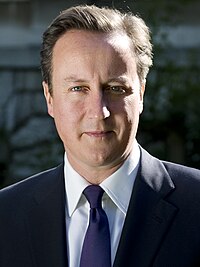
British prime minister David Cameron conducted the first major reshuffle of his coalition government on 4 September 2012. The reshuffle, nearly two and a half years after the government was sworn in, was highly anticipated, and eschewed the trend of annual reshuffles which had become common under the governments of the 1990s and 2000s. As a result, many ministers had been in place not just since the government was elected in 2010, but had covered the portfolio in Cameron's shadow cabinet or even earlier; Andrew Lansley had covered the health brief since 2004, when Michael Howard led the Conservatives in opposition.[1]
Despite this, Cameron's room to manoeuvre was limited by his coalition agreement with Deputy Prime Minister Nick Clegg's Liberal Democrats, which guaranteed the minority party seats in government, and Clegg the right to select his ministers. Further, Cameron's personal aversion to reshuffles and belief that ministers were most effective when given time at a department led to him viewing many cabinet members, including the holders of the Great Offices of State, as immovable.[2]
The reshuffle, which was criticised by the opposition for resulting in a cabinet with only four female members out of twenty-two,[3] ultimately shifted Cameron's government significantly to the right on business, justice, and the environment, and rid the government of perceived weaknesses, while maintaining stability at the top.[4] In an official statement, Number 10 stated that the impetus for the reshuffle was that after more than two years, the government was "at the delivery phase" and that ministers had "been appointed with that in mind".[5]
- ^ Martin, Iain. "David Cameron's reluctant reshuffle". The Telegraph. Retrieved 29 June 2016.
- ^ Martin, Iain. "David Cameron's reluctant reshuffle". The Telegraph. Retrieved 29 June 2016.
- ^ Cecil, Nicholas (24 January 2014). "Cultural leanings for UK: nation of Borat has more women MPs". London Evening Standard. p. 6.
- ^ Wintour, Patrick. "David Cameron's right turn in cabinet reshuffle". The Guardian. Retrieved 29 June 2016.
- ^ Sparrow, Andrew. "Cameron reshuffles his government: Politics live blog". The Guardian. Retrieved 29 June 2016.